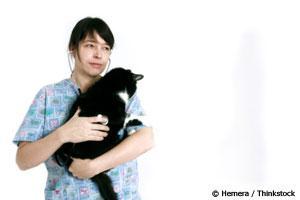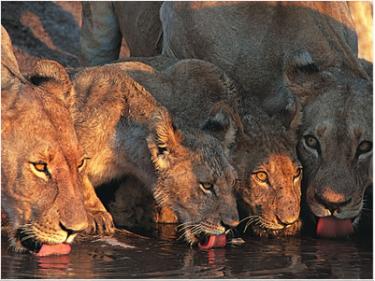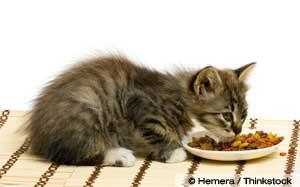Why Cats Hide Pain and the Signs to Look For
 Cats present a special challenge to owners and veterinarians because it’s often difficult to tell when a kitty is in pain. Also, there are a limited amount of pain killing drugs that are safe and effective for felines.
Cats present a special challenge to owners and veterinarians because it’s often difficult to tell when a kitty is in pain. Also, there are a limited amount of pain killing drugs that are safe and effective for felines.- Just because your cat isn’t showing pain doesn’t mean he isn’t feeling pain, and that pain can often be severe. Pain is a serious medical problem, and it’s our job as pet owners to take action when we suspect our cat or dog is hurting.
- Felines instinctively hide their pain as a survival strategy, so it’s important for cat owners to know and look for the subtle signs a kitty is painful.
- There are many causes of pain in cats, from injuries to arthritis to dental disease. Some causes are obvious – others are not. That’s why staying alert for behavior changes and other signs of pain is so important to your cat’s well-being.
- Resolving the root cause of the pain and managing existing pain with a combination of medications and complimentary therapies are the treatment goals for cats who are hurting.
Complete article at: http://healthypets.mercola.com/sites/healthypets/archive/2012/02/03/how-to-know-if-your-cat-is-in-pain-and-what-to-do-about-it.aspx
________
Creation Case Study - Cats
“Recent research from MIT, Virginia Tech and Princeton University analyzed the way cats lap up liquids using only their small, scratchy tongues.”
Source: Digital Vision
They concluded that it involves a process that balances two forces, gravity and inertia. The tip of the tongue rapidly skims the surface, which draws a column of liquid into the cat's mouth. The cat then snaps its mouth shut and captures the drink.
Timing is so critical to the process that without an established rhythm cats wouldn't be able to drink. Domestic cats manage about four laps per second, and each lap brings 0.1 milliliters of liquid into the mouth. Bigger cats have a slower rate of lapping in order to balance gravity and inertia with their size (Richard Alleyne, "How Cats Drink Milk Without Getting Their Chins Wet," Telegraph.co.uk, Nov. 11, 2010). From: http://www.ucg.org/youth/news-creation-case-study-cats/ article by Amanda Stiver
________
The #1 Reason Cats are Surrendered to Shelters
- Inappropriate elimination is the number one reason owners give for relinquishing their cat to an animal shelter. It also accounts for 50 percent of all reported feline behavior problems.
- The three main causes for feline inappropriate elimination are a medical problem, urine marking, and aversion to the litter box.
- A potential underlying medical problem should be ruled out first when a kitty starts eliminating outside the litter box. You’ll also want to determine whether your cat is urine marking or house soiling.
- More often than not, inappropriate elimination is caused by a cat’s aversion to his litter box.
- Litter box aversion can be resolved by identifying and addressing the specific problems your kitty is having with his bathroom facilities.

_______
Pets, Protein, Dry Food and Disease, Nutrition Your Cat Does and Doesn't Need:
“If you’re like most pet owners, your four-legged companion is a beloved member of your family. And just like the humans in your household, you want to give your pet every opportunity for a long and healthy life.
What you might not know is that despite advertising claims, the majority of commercial pet foods are not optimally healthy for your dog or cat. Just as most processed, convenient “people food” is devoid of nutritional value, so is much of the dead, dry pet food sold commercially today.
The pet nutrition industry is very similar to the human food industry – full of hype and false claims, peddling inferior nutritional choices. Much of the so-called “healthy pet foods” on the market contain inferior meat meals, cheap grains like corn and soy, fillers, by-products, food coloring, pesticides, preservatives, and other contaminations.
Unfortunately, most widely available pet foods and even many of the brands conventional vets recommend do not contain clean, inspected ingredients, nor are they biologically balanced for your domesticated carnivore (cat) and scavenging carnivore (dog).” More at: http://healthypets.mercola.com/sites/healthypets/archive/2009/07/07/pets-protein-dry-food-and-disease.aspx
________
Maybe NOW More Cat Parents Will Make the Switch from Dry Food
- Another recently published study has linked feline lower urinary tract disease (FLUTD) – specifically urethral obstruction (UO) – to dry food-only diets.
- Urethral obstructions are most often seen in male cats and are life-threatening. A blocked urethra can cause death in a matter of days.
- Risk factors for feline UO include indoor-only living, obesity, and a diet of dry food (kibble).
- Unlike other species, cats don’t have much of a thirst drive and are designed to get the moisture they need from their food. Dry cat food provides only about one-tenth the amount of moisture cats receive from prey animals, living foods, and even commercial canned diets.
- The vast majority of kitties fed dry food diets live in a state of chronic mild dehydration. This puts significant stress on the kidneys and bladder, which contributes to the development of FLUTD and urethral obstruction.

________
Felines: Lynx, Jaguars, Pumas, Lions...
There are 40 species of feline, and some of them are among the planet's most efficient predators.
The relatives of the domestic house cat include some of the planet's most efficient predators. The 40 species in the feline family have adapted to life in a range of habitats, from the grasslands of Africa to the cold forests of Canada.


Bobcat
America, the solitary bobcat is so named because of its short black, white-tipped tail. Learn more

Jaguar
The jaguar is the largest feline in the Americas, its range once included the Southern United States. Learn more
Leopard
Often competing with lions for prey the leopard uses trees for refuge and to store its meals. Learn more
Lion
The "King of the Jungle" is in fact a creature of the African grasslands and savannas. Learn more
Lynx
The most distinctive features of the lynx are its tufted ears and cheeks and short tail, only 1.5 to 3 inches long. Learn more
September 2005 - Fort Myers, Florida. A highly threatened Florida Panther (Puma concolor coryi) at Babcock Ranch. This CAPTIVE animal resides at the ranch as part of an educational exhibit for schools and tourists. The 92,000 acre Babcock ranch in southwest Florida, protects some of the best wetland and wildlife habitat in the state. © Carlton Ward, Jr.
Puma
Also known as cougar or mountain lion, the puma stalks a wide range of habitats from Canada to South America. Learn moreFrom:http://www.nature.org/newsfeatures/specialfeatures/animals/mammals/mammals-felines.xml
________
The Cat Meat Trade Part 1. Please boycott Asia!!

Trussed and waiting to die. Photo by IFAW.
“Everyday we use products from China, Vietnam, Cambodia, S.Korea and Thailand so we’re all affected by animal trafficking.
The cat meat trade is every bit as bad as the dog trade, except cats get less media attention. In trafficking cats are considered evil vermin that spread disease.
Raised in horrendous conditions, their often trussed for many hours, or days, before being flung into huge cauldrons and boiled alive. It’s common for cats to be thrown into sacks and smashed into the concrete ground, breaking many of their bones and inflicting massive injury before boiling them alive. Once trussed they remain like this until their gruesome death, whenever that may be; it may even be days, leaving the suffering cat in severe muscle pain, bound and unable to move, eat, drink or toilet. There is no mercy. 2 sites I recommend for helping and donating to:
KOREA: International Aid for Korean Animals (IAKA)
THAILAND: Soi Dog Foundation”
Very graphic and heartbreaking. Boycott Asia!
More at: http://pepismartdog.com/dogmeat/?p=384
_________

________
Life for outdoor cats is risky.
"They can get hit by cars; attacked by dogs, other cats, coyotes or wildlife; contract fatal diseases, such as rabies, feline distemper, or feline immunodeficiency virus; get lost, stolen, or poisoned; or suffer during severe weather conditions.
Outdoor cats lead considerably shorter lives on average than cats kept exclusively indoors.
There is no question that birds are better off when cats stay indoors. Exact numbers are unknown, but scientists estimate that every year in the United States alone, cats kill hundreds of millions of birds, and more than a billion small mammals, including rabbits, squirrels, and chipmunks. Feline predators include both domestic cats that spend time outdoors and stray cats that live in the wild, sometimes as part of a colony."
From: http://www.abcbirds.org/abcprograms/policy/cats/index.html
________

________
Save the Panther from the Python Invasion

“In the Everglades, Florida panthers are competing with massive non-native snakes for food sources.
With fewer than 200 left in the wild, the Florida panther is outnumbered by thousands of invasive Burmese pythons in the Everglades. Urge your U.S. representative to help protect the Florida panther from a python invasion. It is estimated that there are more than 30,000 Burmese pythons taking over the Everglades National Park.
The U.S. House of Representatives recently introduced a bill to improve the screening process for wildlife imports, which would help protect native wildlife and keep non-native wildlife from becoming established colonies.
Help protect Florida panthers by editing and sending a message to your representative, urging him or her to support the Invasive Fish and Wildlife Act of 2012.” AT: https://online.nwf.org/site/Advocacy?cmd=display&page=UserAction&id=1627
________
On This Day:
Britain and France declare war on Germany, Sep 3, 1939:
On this day in 1939, in response to Hitler's invasion of Poland, Britain and France, both allies of the overrun nation declare war on Germany.
The first casualty of that declaration was not German—but the British ocean liner Athenia, which was sunk by a German U-30 submarine that had assumed the liner was armed and belligerent. There were more than 1,100 passengers on board, 112 of whom lost their lives. Of those, 28 were Americans, but President Roosevelt was unfazed by the tragedy, declaring that no one was to "thoughtlessly or falsely talk of America sending its armies to European fields." The United States would remain neutral.
As for Britain's response, it was initially no more than the dropping of anti-Nazi propaganda leaflets—13 tons of them—over Germany. They would begin bombing German ships on September 4, suffering significant losses. They were also working under orders not to harm German civilians. The German military, of course, had no such restrictions. France would begin an offensive against Germany's western border two weeks later. Their effort was weakened by a narrow 90-mile window leading to the German front, enclosed by the borders of Luxembourg and Belgium—both neutral countries. The Germans mined the passage, stalling the French offensive.
________
Yesterday:
Muffie arrived at 8.30AM for her grooming, and her ‘Dad’ said that she could stay all day. I let her take a nap on my bed while I got some emails done, and then got everything ready. I cut her long hair down, and before her bath I took her and Misty outside to play for a while. Misty just had to roll around in the dirt!! In the afternoon, I finished grooming her, but as her Dad wouldn’t be home until 4.00 PM, she had another nap. She appreciated the slow pace, and I didn’t get bloodied this time! She is suffering from some dry skin patches, and the vet gives her allergy shots every few months, but they can be bad for her liver, so I had looked for alternatives some months ago.
Kenya arrived with spayed Casey, the mother of the pups that I fostered. She lives next door to Muffie, so we took both dogs down there. Casey’s ‘Dad’ said that now that she was flea-free, he would let her stay in the house. As she had previously been living outside without any flea or heartworm prevention, she has deadly heartworms, so she is on medication for that now. Her ‘Dad’ asked if that was what was making her cough, yes it is! Dogs and cats need to be on heartworm prevention.
A few weeks ago, I had asked Muffie’s ‘Dad’ to put some fish oil on her dinner to help her dry skin, but he hadn’t been doing it. Now that Kenya told him that it is a good thing for him to do, maybe he will do it, and Muffie will get some relief. The capsules can be bought at the Dollar General, and I use a long drywall screw to piece the capsule and squirt it on my dog’s dinner. It is good for any dog, as they often don’t get enough Omega 3’s, especially if they are on commercial pet food. If you can afford it Krill Oil is better.
Didn’t even get the laundry done, I had such a busy day.















6 comments:
The last time my Muffy came back from the groomers he couldn't get all the knots and tangles out so I have been working on her e few seconds a day. Next time maybe she should be shaved. It has been many years since she looked like a Shi Tzu.
Thank you for your comment, DD.
Most times the groomer will use a #10 blade for shaving a dog down, but that ruins their undercoat, and they tangle easier as they grow out. I never use anything shorter than a #7 blade, if they are matted all over.
If their 'parents' want them fairly short, I put Shi Tzus and Lhasas in a "Lhasa puppy cut" with a 3-3/4FC blade, which is the accepted blade for a Lhasa/Shi Tzu puppy cut, and leaves the hair at a pretty length so they don't look scalped!
Your groomer must not have the same equipment that I have, I would never send a dog home with knots or tangles, but I don't want to cause the dog any discomfort either. I have a very safe mat splitter that takes the old timey injector blades. It makes short work of bad tangles.
Don't forget, I started grooming 50years ago, and I still have tools that can't be bought now!
Happy Tails, and Trails, Penny
PS. Don't bathe a dog when it is tangled, it makes "wet-mats' that are tightly clumped together, and very difficult to remove. Brush the dog first. If you can't get them all out first, try easing the mats out while they are still wet, and before you brush-dry the dog.
Slicker brushes work the best.
Thanks Penny. Good and useful information for our two fur kids, Katie and Alex. Alex gets stressed and when that happens he starts his marking habit. Feliway helps reduce the stress. Being fulltime RVers means lots of changes for kitty which causes the stress. Also, both Alex and Katie purrfer RV sites amongst the trees rather than in wide open spaces. Anyhow, thanks again for your post.
Thanks for your comment, Darrell and Judy.
I am glad that the info is useful for Katie and Alex.
Fortunately, my cat loved to go RVing. She didn't mind traveling in her carrier which was strapped in with a seat belt, so that it wouldn't rock and roll. She felt safe in her own little den.
She had a harness and we would walk in the campgrounds. She also had a pet stroller for when she was older. Then she would sit on the picnic bench with us, people watching. We preferred to be under the trees, too.
I miss her very much.
Happy Tails and Trails, Penny.
Post a Comment